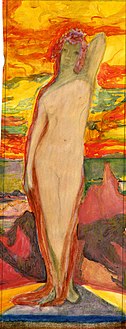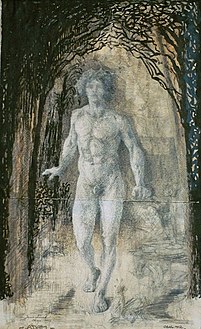Jens Lund

Jens Martin Victor Lund (18 November 1871, Copenhagen – 10 June 1924, Hellerup) was a Danish painter, designer and graphic artist.
Studies
His father was a cabinetmaker for the Royal Court. He left school in 1886, after the loss of both of his parents left him with a nervous ailment, and became a student of the painter, Axel Hou. Although he also studied silviculture and law, he eventually decided to focus on art as a career. He was married in 1893 to the daughter of a local catechist.[1]
He spent a year working with Jens Jensen-Egeberg, but his greatest inspiration came during a stay in Paris from 1896 to 1899, when he studied at the Académie Julian with Tony Robert-Fleury and became acquainted with his fellow Danish artists, Rudolph Tegner, Johannes Holbek and Niels Hansen Jacobsen.[2]
This was followed by a long series of travels; many in the company of Tegner. His trips included Italy (1901-1903 and 1905-1907), Greece (1902), Spain and Morocco (1905), Bruges (1909) and Gotland (1910).[2]
Throughout his work, he attempted to forge a connection between writing and graphic expression; publishing two works with text to advance his goal: Livets Skov (Living Forest) and Forvandlede Blomster (Transformed Flowers). Asger Jorn considered some of his early works to be forerunners of Surrealism. His later works were more naturalistic.[2]
In an unpublished memoir, Mindet og Nuet (Memories and the Present) from 1921, he described the life of the Danish art community in Paris and their attraction to Symbolism and Art Nouveau.[2] He was president of the Graphic Arts Society from 1921 until his death.[1]
Among his numerous book illustrations are those for Brand by Henrik Ibsen, Bruges-la-Morte by Georges Rodenbach (translated by Lund and his wife)[1] and Les Fleurs du Mal by Charles Baudelaire.
Gallery
-
The Son of Jacob
-
Illustration from
Les Fleurs du Mal -
Princess
References
- ^ a b c Brief biography @ the Vejen Kunstmuseum.
- ^ a b c d Biographical notes @ Kunstindeks Danmark.
External links
![]() Media related to Jens Lund at Wikimedia Commons
Media related to Jens Lund at Wikimedia Commons





